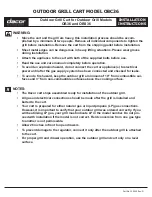
2
2
2-6
2-6
Functions > Basic Function > IP address setting order
Functions > Basic Function > IP address setting order
IP address setting order
Following is described on condition that each protocol is set to on.
IP address setting order
- At startup, if [DHCP/BOOTP] in user data is set to on, it enables a user to obtain IP Address.
- At startup, if [RARP] in user data is set to on, it enables a user to obtain IP Address.
- If automatic obtainment of IP Address fails, a network works with the IP Address specified at
[IP Address] in user data.
- At startup, if [Automatic address obtainment] in user data is set to off, a network works with
the data specified at [IP Address], [Subnet Mask], [Default Gateway], or [DNS Server] in user
data.
- If automatic obtainment of IP Address fails or if IP Address specified at [IP Address] in user
data is 0.0.0.0, IP Address can be set by either ARP method or Canon Configuration Protocol
V3 method. If data of [Network setting] in user data are changed, the change becomes
effective after the power is turned off and on.
List of available protocols
Hierarchy
Protocol
Protocol
Outline
Network layer
ARP
Address Resolution
Protocol
This is used to obtain MAC address of
device from IP address
RARP
Reverse Address
Resolution Protocol
This is used to obtain IP address of device
from MAC address.
IP
Internet Protocol
This is a number (no overlaps) to identify
own device or other device on the network.
ICMP
Internet Control Message
Protocol
This is used to return error to the source
when IP transmission trouble occurs.
This is used to reply to ping command or
others.
Transport layer TCP
Transmission Control
Protocol
This is a connection type protocol on the
IP.
A system to check transmitted data is
incorporated.
UDP
User Datagram Protocol This is a connection-less type protocol on
the IP.
This is lower in credibility compared with
TCP, but is used in DHCP or SNMP, as the
processing uses less memory.
Session layer
Application layer
Port-9100 Port-9100(rawTCP)
Port-9100(rawTCP)
This is used to print data sent to the port
number 9100 of TCP.
Port-9100 is available when [Use
Port-9100] in user data is set to [Use] and
[Port number of Port-9100] is set.
This supports interactive communication
(send/receive).
LPR/LPD Line Printer Remote/Line
Printer Demon
LPR is a command to output data to the
network printer.
LPD is a system to receive LPR command.
This supports only one-way communication
(to device).
This does not support queue.
LPD function is available when [Use LPD]
in user data is set to [Use] and [LPD port
number] in user data is set.
HTTP
Hyper Text Transfer
Protocol
This is a protocol to send/receive contents
between Web server and Client. It is used
in RemoteUI.
SNMP
Simple Network
Management Protocol
This is a protocol to manage clients
connecting to the network.
It enables to collect device information by
using MIB (Message Information Base) on
the SNMP.
SNMP function is available when [Use
SNMP] in user data is set to [Use] and
[SNMP port number] in user data is set.
BOOTP/
DHCP
BOOTstrap Protocol/
Dynamic Host
Configuration Protocol
BOOTP is used to obtain settings of IP
address, Subnet Mask, Default Gateway,
or DNS Server Address.
DHCP, improved BOOTP, has a function to
distribute IP Address to clients.
DNS
Resolver
Domain Name System
Resolver
This is software to carry out name
resolution of computer and IP address
by registering name server to inquiry in
advance.
















































